Literature Review: Analysis of Australian Retail Industry Challenges
VerifiedAdded on 2022/09/09
|15
|3339
|5
Report
AI Summary
This report provides a comprehensive literature review of the Australian retail industry, analyzing several journal articles to identify key challenges and strategies. The review begins with an examination of labor management in supermarkets, focusing on the control of frontline service workers through bureaucratic and info-normative methods, as observed in an Australian retail supermarket case. It then explores how an Australian retailer leveraged enterprise architecture to enable business transformation, examining the processes and outcomes of this change. The report also delves into location-based pricing and channel selection in a dual supply chain context, using a case study from the food retail industry to analyze the impact of location and demand on pricing strategies. Finally, the review compares union power dynamics in the retail sectors of Australia and New Zealand, highlighting different strategies and their effects on employee management and industry outcomes. The report aims to provide a detailed overview of the retail industry, discussing the challenges and strategies involved.

qwertyuiopasdfghjklzxcvbnmqw
ertyuiopasdfghjklzxcvbnmqwert
yuiopasdfghjklzxcvbnmqwertyui
opasdfghjklzxcvbnmqwertyuiop
asdfghjklzxcvbnmqwertyuiopasd
fghjklzxcvbnmqwertyuiopasdfgh
jklzxcvbnmqwertyuiopasdfghjkl
zxcvbnmqwertyuiopasdfghjklzxc
vbnmqwertyuiopasdfghjklzxcvb
nmqwertyuiopasdfghjklzxcvbnm
qwertyuiopasdfghjklzxcvbnmqw
ertyuiopasdfghjklzxcvbnmqwert
yuiopasdfghjklzxcvbnmqwertyui
opasdfghjklzxcvbnmqwertyuiop
asdfghjklzxcvbnmqwertyuiopasd
fghjklzxcvbnmqwertyuiopasdfgh
jklzxcvbnmrtyuiopasdfghjklzxcv
Literature Review Guidelines
Journal Article Analysis
12/18/2019
ertyuiopasdfghjklzxcvbnmqwert
yuiopasdfghjklzxcvbnmqwertyui
opasdfghjklzxcvbnmqwertyuiop
asdfghjklzxcvbnmqwertyuiopasd
fghjklzxcvbnmqwertyuiopasdfgh
jklzxcvbnmqwertyuiopasdfghjkl
zxcvbnmqwertyuiopasdfghjklzxc
vbnmqwertyuiopasdfghjklzxcvb
nmqwertyuiopasdfghjklzxcvbnm
qwertyuiopasdfghjklzxcvbnmqw
ertyuiopasdfghjklzxcvbnmqwert
yuiopasdfghjklzxcvbnmqwertyui
opasdfghjklzxcvbnmqwertyuiop
asdfghjklzxcvbnmqwertyuiopasd
fghjklzxcvbnmqwertyuiopasdfgh
jklzxcvbnmrtyuiopasdfghjklzxcv
Literature Review Guidelines
Journal Article Analysis
12/18/2019
Paraphrase This Document
Need a fresh take? Get an instant paraphrase of this document with our AI Paraphraser
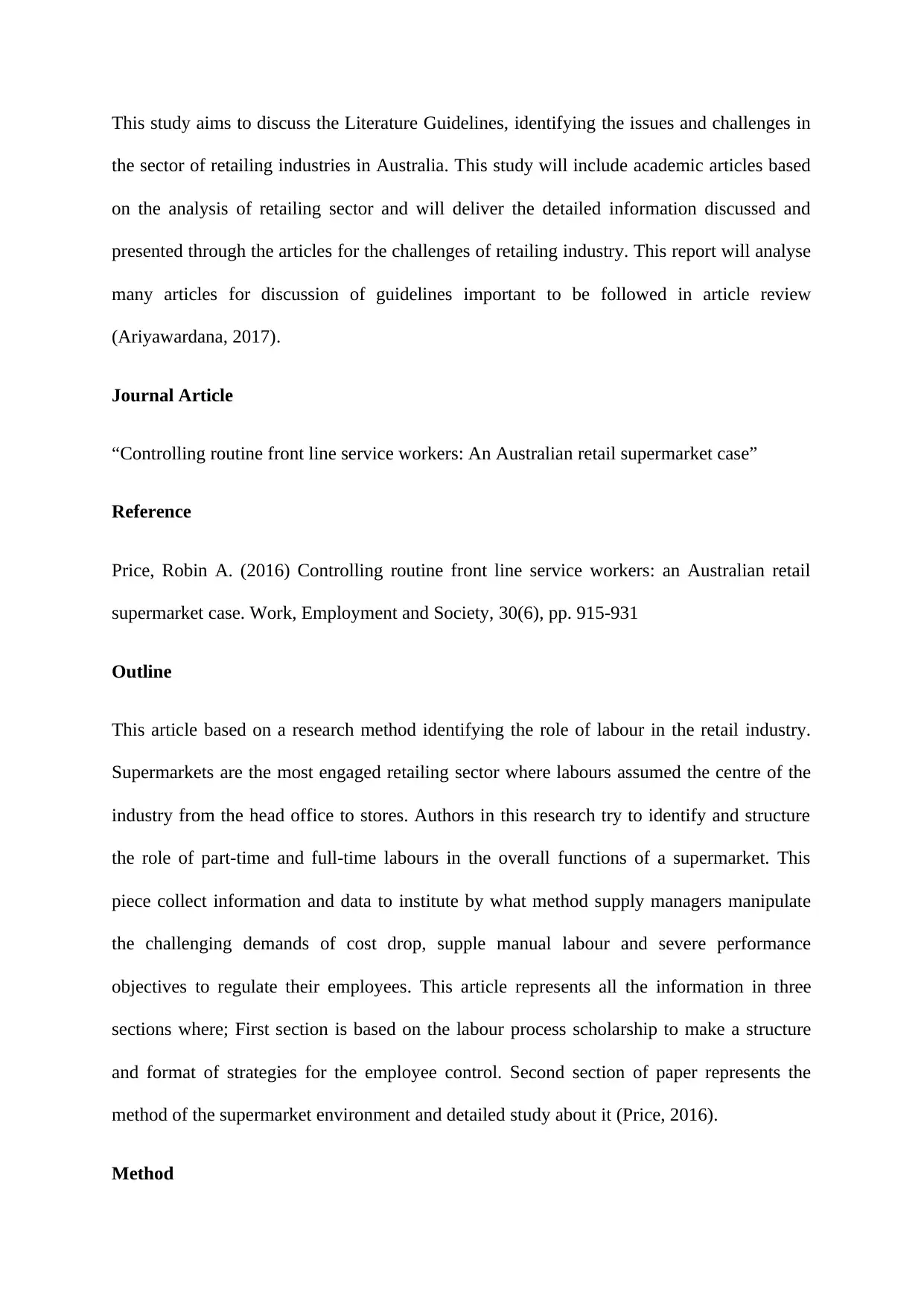
This study aims to discuss the Literature Guidelines, identifying the issues and challenges in
the sector of retailing industries in Australia. This study will include academic articles based
on the analysis of retailing sector and will deliver the detailed information discussed and
presented through the articles for the challenges of retailing industry. This report will analyse
many articles for discussion of guidelines important to be followed in article review
(Ariyawardana, 2017).
Journal Article
“Controlling routine front line service workers: An Australian retail supermarket case”
Reference
Price, Robin A. (2016) Controlling routine front line service workers: an Australian retail
supermarket case. Work, Employment and Society, 30(6), pp. 915-931
Outline
This article based on a research method identifying the role of labour in the retail industry.
Supermarkets are the most engaged retailing sector where labours assumed the centre of the
industry from the head office to stores. Authors in this research try to identify and structure
the role of part-time and full-time labours in the overall functions of a supermarket. This
piece collect information and data to institute by what method supply managers manipulate
the challenging demands of cost drop, supple manual labour and severe performance
objectives to regulate their employees. This article represents all the information in three
sections where; First section is based on the labour process scholarship to make a structure
and format of strategies for the employee control. Second section of paper represents the
method of the supermarket environment and detailed study about it (Price, 2016).
Method
the sector of retailing industries in Australia. This study will include academic articles based
on the analysis of retailing sector and will deliver the detailed information discussed and
presented through the articles for the challenges of retailing industry. This report will analyse
many articles for discussion of guidelines important to be followed in article review
(Ariyawardana, 2017).
Journal Article
“Controlling routine front line service workers: An Australian retail supermarket case”
Reference
Price, Robin A. (2016) Controlling routine front line service workers: an Australian retail
supermarket case. Work, Employment and Society, 30(6), pp. 915-931
Outline
This article based on a research method identifying the role of labour in the retail industry.
Supermarkets are the most engaged retailing sector where labours assumed the centre of the
industry from the head office to stores. Authors in this research try to identify and structure
the role of part-time and full-time labours in the overall functions of a supermarket. This
piece collect information and data to institute by what method supply managers manipulate
the challenging demands of cost drop, supple manual labour and severe performance
objectives to regulate their employees. This article represents all the information in three
sections where; First section is based on the labour process scholarship to make a structure
and format of strategies for the employee control. Second section of paper represents the
method of the supermarket environment and detailed study about it (Price, 2016).
Method
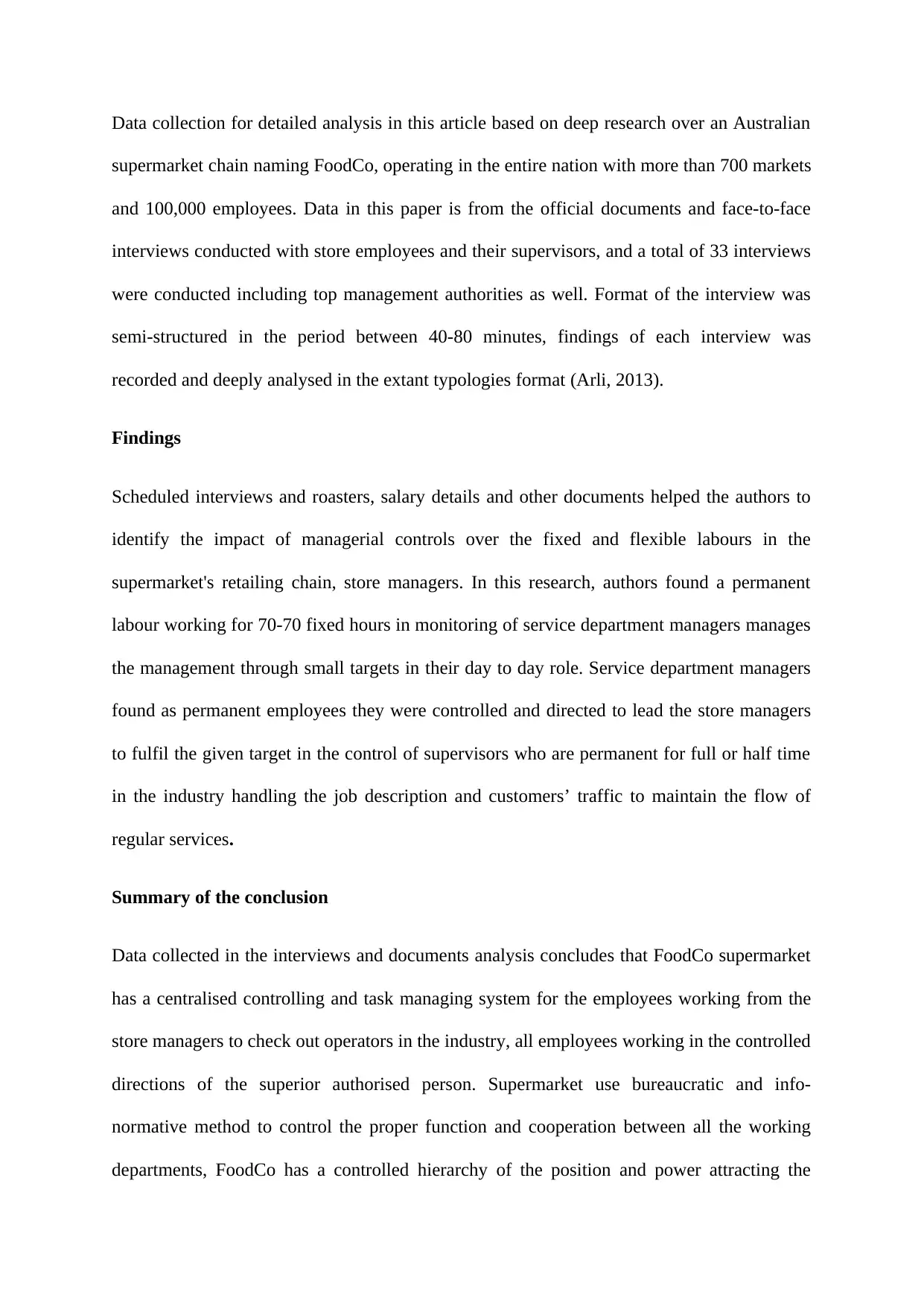
Data collection for detailed analysis in this article based on deep research over an Australian
supermarket chain naming FoodCo, operating in the entire nation with more than 700 markets
and 100,000 employees. Data in this paper is from the official documents and face-to-face
interviews conducted with store employees and their supervisors, and a total of 33 interviews
were conducted including top management authorities as well. Format of the interview was
semi-structured in the period between 40-80 minutes, findings of each interview was
recorded and deeply analysed in the extant typologies format (Arli, 2013).
Findings
Scheduled interviews and roasters, salary details and other documents helped the authors to
identify the impact of managerial controls over the fixed and flexible labours in the
supermarket's retailing chain, store managers. In this research, authors found a permanent
labour working for 70-70 fixed hours in monitoring of service department managers manages
the management through small targets in their day to day role. Service department managers
found as permanent employees they were controlled and directed to lead the store managers
to fulfil the given target in the control of supervisors who are permanent for full or half time
in the industry handling the job description and customers’ traffic to maintain the flow of
regular services.
Summary of the conclusion
Data collected in the interviews and documents analysis concludes that FoodCo supermarket
has a centralised controlling and task managing system for the employees working from the
store managers to check out operators in the industry, all employees working in the controlled
directions of the superior authorised person. Supermarket use bureaucratic and info-
normative method to control the proper function and cooperation between all the working
departments, FoodCo has a controlled hierarchy of the position and power attracting the
supermarket chain naming FoodCo, operating in the entire nation with more than 700 markets
and 100,000 employees. Data in this paper is from the official documents and face-to-face
interviews conducted with store employees and their supervisors, and a total of 33 interviews
were conducted including top management authorities as well. Format of the interview was
semi-structured in the period between 40-80 minutes, findings of each interview was
recorded and deeply analysed in the extant typologies format (Arli, 2013).
Findings
Scheduled interviews and roasters, salary details and other documents helped the authors to
identify the impact of managerial controls over the fixed and flexible labours in the
supermarket's retailing chain, store managers. In this research, authors found a permanent
labour working for 70-70 fixed hours in monitoring of service department managers manages
the management through small targets in their day to day role. Service department managers
found as permanent employees they were controlled and directed to lead the store managers
to fulfil the given target in the control of supervisors who are permanent for full or half time
in the industry handling the job description and customers’ traffic to maintain the flow of
regular services.
Summary of the conclusion
Data collected in the interviews and documents analysis concludes that FoodCo supermarket
has a centralised controlling and task managing system for the employees working from the
store managers to check out operators in the industry, all employees working in the controlled
directions of the superior authorised person. Supermarket use bureaucratic and info-
normative method to control the proper function and cooperation between all the working
departments, FoodCo has a controlled hierarchy of the position and power attracting the
⊘ This is a preview!⊘
Do you want full access?
Subscribe today to unlock all pages.

Trusted by 1+ million students worldwide
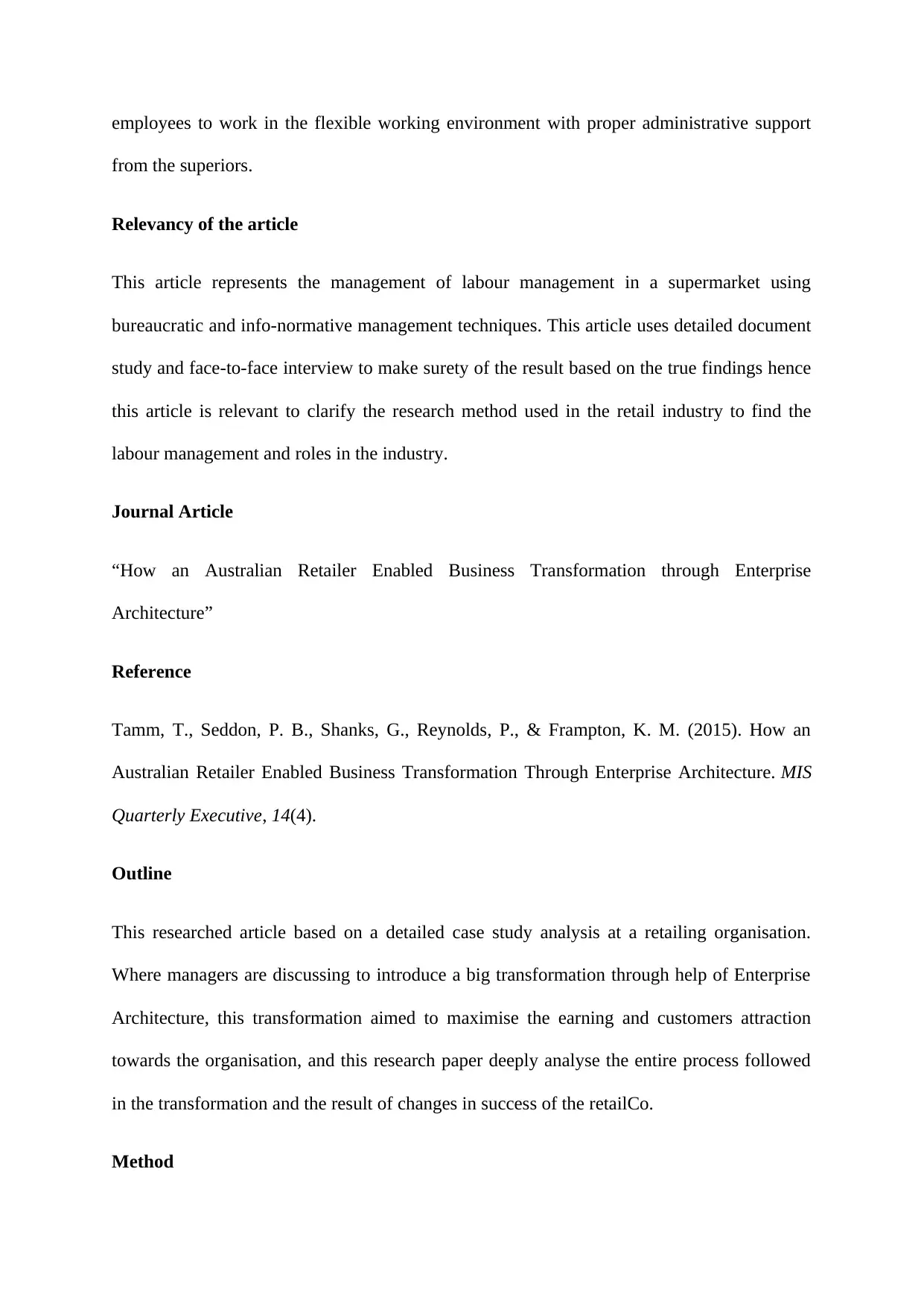
employees to work in the flexible working environment with proper administrative support
from the superiors.
Relevancy of the article
This article represents the management of labour management in a supermarket using
bureaucratic and info-normative management techniques. This article uses detailed document
study and face-to-face interview to make surety of the result based on the true findings hence
this article is relevant to clarify the research method used in the retail industry to find the
labour management and roles in the industry.
Journal Article
“How an Australian Retailer Enabled Business Transformation through Enterprise
Architecture”
Reference
Tamm, T., Seddon, P. B., Shanks, G., Reynolds, P., & Frampton, K. M. (2015). How an
Australian Retailer Enabled Business Transformation Through Enterprise Architecture. MIS
Quarterly Executive, 14(4).
Outline
This researched article based on a detailed case study analysis at a retailing organisation.
Where managers are discussing to introduce a big transformation through help of Enterprise
Architecture, this transformation aimed to maximise the earning and customers attraction
towards the organisation, and this research paper deeply analyse the entire process followed
in the transformation and the result of changes in success of the retailCo.
Method
from the superiors.
Relevancy of the article
This article represents the management of labour management in a supermarket using
bureaucratic and info-normative management techniques. This article uses detailed document
study and face-to-face interview to make surety of the result based on the true findings hence
this article is relevant to clarify the research method used in the retail industry to find the
labour management and roles in the industry.
Journal Article
“How an Australian Retailer Enabled Business Transformation through Enterprise
Architecture”
Reference
Tamm, T., Seddon, P. B., Shanks, G., Reynolds, P., & Frampton, K. M. (2015). How an
Australian Retailer Enabled Business Transformation Through Enterprise Architecture. MIS
Quarterly Executive, 14(4).
Outline
This researched article based on a detailed case study analysis at a retailing organisation.
Where managers are discussing to introduce a big transformation through help of Enterprise
Architecture, this transformation aimed to maximise the earning and customers attraction
towards the organisation, and this research paper deeply analyse the entire process followed
in the transformation and the result of changes in success of the retailCo.
Method
Paraphrase This Document
Need a fresh take? Get an instant paraphrase of this document with our AI Paraphraser
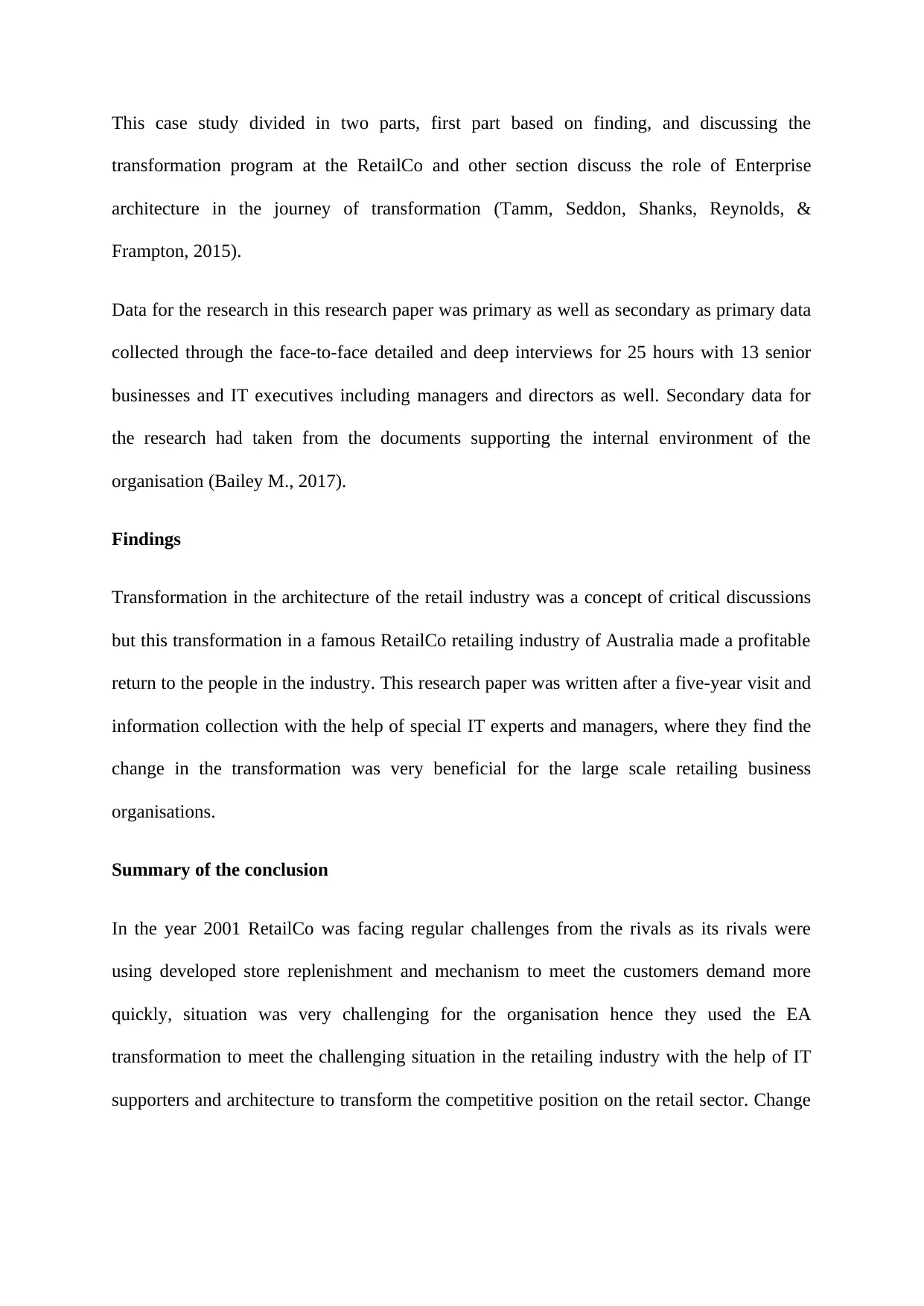
This case study divided in two parts, first part based on finding, and discussing the
transformation program at the RetailCo and other section discuss the role of Enterprise
architecture in the journey of transformation (Tamm, Seddon, Shanks, Reynolds, &
Frampton, 2015).
Data for the research in this research paper was primary as well as secondary as primary data
collected through the face-to-face detailed and deep interviews for 25 hours with 13 senior
businesses and IT executives including managers and directors as well. Secondary data for
the research had taken from the documents supporting the internal environment of the
organisation (Bailey M., 2017).
Findings
Transformation in the architecture of the retail industry was a concept of critical discussions
but this transformation in a famous RetailCo retailing industry of Australia made a profitable
return to the people in the industry. This research paper was written after a five-year visit and
information collection with the help of special IT experts and managers, where they find the
change in the transformation was very beneficial for the large scale retailing business
organisations.
Summary of the conclusion
In the year 2001 RetailCo was facing regular challenges from the rivals as its rivals were
using developed store replenishment and mechanism to meet the customers demand more
quickly, situation was very challenging for the organisation hence they used the EA
transformation to meet the challenging situation in the retailing industry with the help of IT
supporters and architecture to transform the competitive position on the retail sector. Change
transformation program at the RetailCo and other section discuss the role of Enterprise
architecture in the journey of transformation (Tamm, Seddon, Shanks, Reynolds, &
Frampton, 2015).
Data for the research in this research paper was primary as well as secondary as primary data
collected through the face-to-face detailed and deep interviews for 25 hours with 13 senior
businesses and IT executives including managers and directors as well. Secondary data for
the research had taken from the documents supporting the internal environment of the
organisation (Bailey M., 2017).
Findings
Transformation in the architecture of the retail industry was a concept of critical discussions
but this transformation in a famous RetailCo retailing industry of Australia made a profitable
return to the people in the industry. This research paper was written after a five-year visit and
information collection with the help of special IT experts and managers, where they find the
change in the transformation was very beneficial for the large scale retailing business
organisations.
Summary of the conclusion
In the year 2001 RetailCo was facing regular challenges from the rivals as its rivals were
using developed store replenishment and mechanism to meet the customers demand more
quickly, situation was very challenging for the organisation hence they used the EA
transformation to meet the challenging situation in the retailing industry with the help of IT
supporters and architecture to transform the competitive position on the retail sector. Change
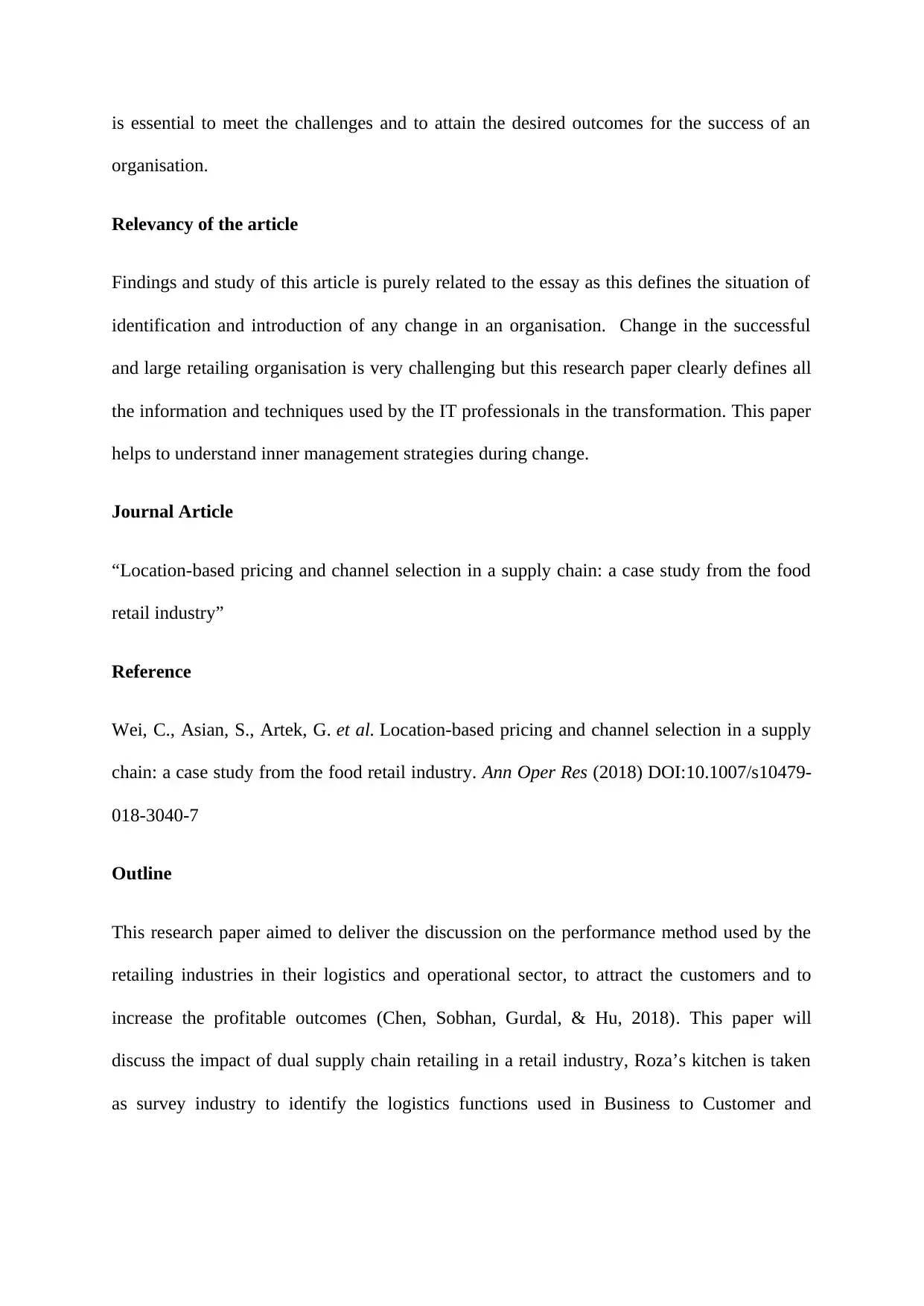
is essential to meet the challenges and to attain the desired outcomes for the success of an
organisation.
Relevancy of the article
Findings and study of this article is purely related to the essay as this defines the situation of
identification and introduction of any change in an organisation. Change in the successful
and large retailing organisation is very challenging but this research paper clearly defines all
the information and techniques used by the IT professionals in the transformation. This paper
helps to understand inner management strategies during change.
Journal Article
“Location-based pricing and channel selection in a supply chain: a case study from the food
retail industry”
Reference
Wei, C., Asian, S., Artek, G. et al. Location-based pricing and channel selection in a supply
chain: a case study from the food retail industry. Ann Oper Res (2018) DOI:10.1007/s10479-
018-3040-7
Outline
This research paper aimed to deliver the discussion on the performance method used by the
retailing industries in their logistics and operational sector, to attract the customers and to
increase the profitable outcomes (Chen, Sobhan, Gurdal, & Hu, 2018). This paper will
discuss the impact of dual supply chain retailing in a retail industry, Roza’s kitchen is taken
as survey industry to identify the logistics functions used in Business to Customer and
organisation.
Relevancy of the article
Findings and study of this article is purely related to the essay as this defines the situation of
identification and introduction of any change in an organisation. Change in the successful
and large retailing organisation is very challenging but this research paper clearly defines all
the information and techniques used by the IT professionals in the transformation. This paper
helps to understand inner management strategies during change.
Journal Article
“Location-based pricing and channel selection in a supply chain: a case study from the food
retail industry”
Reference
Wei, C., Asian, S., Artek, G. et al. Location-based pricing and channel selection in a supply
chain: a case study from the food retail industry. Ann Oper Res (2018) DOI:10.1007/s10479-
018-3040-7
Outline
This research paper aimed to deliver the discussion on the performance method used by the
retailing industries in their logistics and operational sector, to attract the customers and to
increase the profitable outcomes (Chen, Sobhan, Gurdal, & Hu, 2018). This paper will
discuss the impact of dual supply chain retailing in a retail industry, Roza’s kitchen is taken
as survey industry to identify the logistics functions used in Business to Customer and
⊘ This is a preview!⊘
Do you want full access?
Subscribe today to unlock all pages.

Trusted by 1+ million students worldwide

Business to Business method of the industry and how the location and demand affects the
pricing and other business strategies of an organisation (Brewer & Terence, 2016).
Method
Authors in this research paper use literature review and detailed analysis of the internal
management in Dual-supply chain pricing methods with logistic determinants of the price
analysing the impact of different situations like customers demand and supply changes in the
industry. This research paper also includes process followed by the industry to meet the
customers demand in the forecasted time. Authors also describe the online and offline order
delivery and process of the organisation and factors affecting the price determination
according to the situation and location.
Findings
Findings of this article based on two models first model of research were Benchmark model
and other was proposed, model. These models based to find decision variables affecting the
pricing decision for the online and offline customers in a newly established retailing chain.
Authors find differences in the services offered for the offline ad online ordering customers
and the price of the service was different for both, location also played an important role in
the price determination because an online delivery required many others cost to the industry
as well. Hence, location and demands in a dual supply chain affects the pricing strategy in the
retail industry.
Summary of the conclusion
This article describes the decision-making process of an organisation in the retailing industry,
the proposed model was found more relevant and profitmaking model than the benchmark
model, as in the proposed model retailing organisation is free to design its supply structure
pricing and other business strategies of an organisation (Brewer & Terence, 2016).
Method
Authors in this research paper use literature review and detailed analysis of the internal
management in Dual-supply chain pricing methods with logistic determinants of the price
analysing the impact of different situations like customers demand and supply changes in the
industry. This research paper also includes process followed by the industry to meet the
customers demand in the forecasted time. Authors also describe the online and offline order
delivery and process of the organisation and factors affecting the price determination
according to the situation and location.
Findings
Findings of this article based on two models first model of research were Benchmark model
and other was proposed, model. These models based to find decision variables affecting the
pricing decision for the online and offline customers in a newly established retailing chain.
Authors find differences in the services offered for the offline ad online ordering customers
and the price of the service was different for both, location also played an important role in
the price determination because an online delivery required many others cost to the industry
as well. Hence, location and demands in a dual supply chain affects the pricing strategy in the
retail industry.
Summary of the conclusion
This article describes the decision-making process of an organisation in the retailing industry,
the proposed model was found more relevant and profitmaking model than the benchmark
model, as in the proposed model retailing organisation is free to design its supply structure
Paraphrase This Document
Need a fresh take? Get an instant paraphrase of this document with our AI Paraphraser

for the offline and online customers. Based on the cost parameters, an organisation delivering
the products and services at the doorstep has to bear many hidden charges in form of labour,
riding and also packaging cost for the safe delivery hence proposed model offer cost
changing parameters for the retailing industry using dual-supply chain strategy.
Relevancy of the article
This article is based on the comparing strategy to identify the most suitable model for the cost
and price determination in a retail organisation offering a dual-supply chain system for the
delivery of its food and other grocery items. This article is useful in the assessment as it
represents the comparing method to identify the best tool in the organisation for success.
Journal Article
“Union Power in Retail: Contrasting cases in Australia and New Zealand”
Reference
Bailey, Janis, Price, Robin A., Pyman, Amanda, & Parker, Jane (2015) Union power in retail:
Contrasting cases in Australia and New Zealand. New Zealand Journal of Employment
Relations, 40(1), pp. 1-18.
Outline
This article is based on comparative research conducted in the power practices by the union
labours in the retailing industry. This study aims to compare and find the result of the
following questions based on two different labour unions; the first question was to identify
the strategies used by the unions in bargaining and employees management. Second thing to
identify among the union was outcomes occurred in terms of profits and the last thing was to
identify the nature and place of union power in the retail industry (Bailey J. P., 2015).
the products and services at the doorstep has to bear many hidden charges in form of labour,
riding and also packaging cost for the safe delivery hence proposed model offer cost
changing parameters for the retailing industry using dual-supply chain strategy.
Relevancy of the article
This article is based on the comparing strategy to identify the most suitable model for the cost
and price determination in a retail organisation offering a dual-supply chain system for the
delivery of its food and other grocery items. This article is useful in the assessment as it
represents the comparing method to identify the best tool in the organisation for success.
Journal Article
“Union Power in Retail: Contrasting cases in Australia and New Zealand”
Reference
Bailey, Janis, Price, Robin A., Pyman, Amanda, & Parker, Jane (2015) Union power in retail:
Contrasting cases in Australia and New Zealand. New Zealand Journal of Employment
Relations, 40(1), pp. 1-18.
Outline
This article is based on comparative research conducted in the power practices by the union
labours in the retailing industry. This study aims to compare and find the result of the
following questions based on two different labour unions; the first question was to identify
the strategies used by the unions in bargaining and employees management. Second thing to
identify among the union was outcomes occurred in terms of profits and the last thing was to
identify the nature and place of union power in the retail industry (Bailey J. P., 2015).
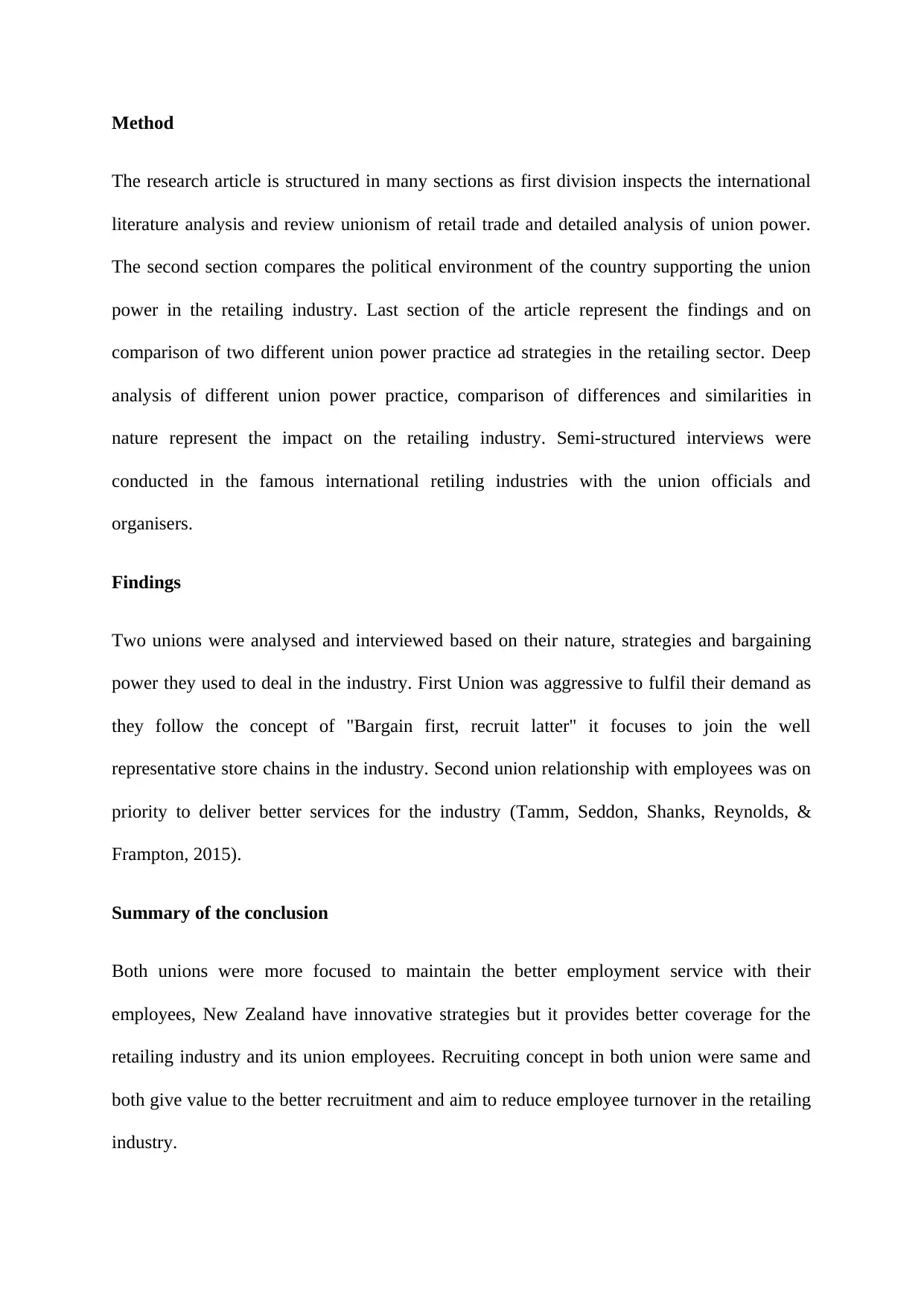
Method
The research article is structured in many sections as first division inspects the international
literature analysis and review unionism of retail trade and detailed analysis of union power.
The second section compares the political environment of the country supporting the union
power in the retailing industry. Last section of the article represent the findings and on
comparison of two different union power practice ad strategies in the retailing sector. Deep
analysis of different union power practice, comparison of differences and similarities in
nature represent the impact on the retailing industry. Semi-structured interviews were
conducted in the famous international retiling industries with the union officials and
organisers.
Findings
Two unions were analysed and interviewed based on their nature, strategies and bargaining
power they used to deal in the industry. First Union was aggressive to fulfil their demand as
they follow the concept of "Bargain first, recruit latter" it focuses to join the well
representative store chains in the industry. Second union relationship with employees was on
priority to deliver better services for the industry (Tamm, Seddon, Shanks, Reynolds, &
Frampton, 2015).
Summary of the conclusion
Both unions were more focused to maintain the better employment service with their
employees, New Zealand have innovative strategies but it provides better coverage for the
retailing industry and its union employees. Recruiting concept in both union were same and
both give value to the better recruitment and aim to reduce employee turnover in the retailing
industry.
The research article is structured in many sections as first division inspects the international
literature analysis and review unionism of retail trade and detailed analysis of union power.
The second section compares the political environment of the country supporting the union
power in the retailing industry. Last section of the article represent the findings and on
comparison of two different union power practice ad strategies in the retailing sector. Deep
analysis of different union power practice, comparison of differences and similarities in
nature represent the impact on the retailing industry. Semi-structured interviews were
conducted in the famous international retiling industries with the union officials and
organisers.
Findings
Two unions were analysed and interviewed based on their nature, strategies and bargaining
power they used to deal in the industry. First Union was aggressive to fulfil their demand as
they follow the concept of "Bargain first, recruit latter" it focuses to join the well
representative store chains in the industry. Second union relationship with employees was on
priority to deliver better services for the industry (Tamm, Seddon, Shanks, Reynolds, &
Frampton, 2015).
Summary of the conclusion
Both unions were more focused to maintain the better employment service with their
employees, New Zealand have innovative strategies but it provides better coverage for the
retailing industry and its union employees. Recruiting concept in both union were same and
both give value to the better recruitment and aim to reduce employee turnover in the retailing
industry.
⊘ This is a preview!⊘
Do you want full access?
Subscribe today to unlock all pages.

Trusted by 1+ million students worldwide

Relevancy of the article
This article based on comparing the union power and role in the retailing industry
Wesfarmers, Woolworths and Coles are leading retailing industries in New Zealand and
Australia. This paper is helpful to understand the international perspective supporting the
union power in the bargaining and recruiting the employees’ services in the supermarkets
better comparison between two unions allows to understanding role of comparative study in
the retail industry.
Journal Article
“Regulating the sale of tobacco in New Zealand: A qualitative analysis of retailers’ views and
implications for advocacy”
Reference
Robertson, L., Marsh, L., Hoek, J., McGee, R., & Egan, R. (2015). Regulating the sale of
tobacco in New Zealand: A qualitative analysis of retailers’ views and implications for
advocacy. International Journal of Drug Policy, 26(12), 1222–1230.
DOI:10.1016/j.drugpo.2015.08.015
Outline
Regulatory control over the retailing industry plays a significant role in the success of the
retailing industry, the government of New Zealand is involved in banning the sale of tobacco
with the aim of making the country free from tobacco. This paper aims to identify the role
played by the government in controlling and regulating the sale of alcohol and tobacco, a
survey conducted in the retailing industries to get the idea about policies for getting the
licence to sell the alcohol and tobacco (Lindsay, Louise, Janet, Rob, & Richard, 2015).
Method
This article based on comparing the union power and role in the retailing industry
Wesfarmers, Woolworths and Coles are leading retailing industries in New Zealand and
Australia. This paper is helpful to understand the international perspective supporting the
union power in the bargaining and recruiting the employees’ services in the supermarkets
better comparison between two unions allows to understanding role of comparative study in
the retail industry.
Journal Article
“Regulating the sale of tobacco in New Zealand: A qualitative analysis of retailers’ views and
implications for advocacy”
Reference
Robertson, L., Marsh, L., Hoek, J., McGee, R., & Egan, R. (2015). Regulating the sale of
tobacco in New Zealand: A qualitative analysis of retailers’ views and implications for
advocacy. International Journal of Drug Policy, 26(12), 1222–1230.
DOI:10.1016/j.drugpo.2015.08.015
Outline
Regulatory control over the retailing industry plays a significant role in the success of the
retailing industry, the government of New Zealand is involved in banning the sale of tobacco
with the aim of making the country free from tobacco. This paper aims to identify the role
played by the government in controlling and regulating the sale of alcohol and tobacco, a
survey conducted in the retailing industries to get the idea about policies for getting the
licence to sell the alcohol and tobacco (Lindsay, Louise, Janet, Rob, & Richard, 2015).
Method
Paraphrase This Document
Need a fresh take? Get an instant paraphrase of this document with our AI Paraphraser

Findings of this article are based face-to-face interview with the managers and retail owners
of the organisation selling tobacco; in the industry of New Zealand, this semi-structured
interview was prepared based on prevailing regulations and policies for restricting the
tobacco selling and permitting the retailers to sell these in the country. Besides the interview,
this research paper also includes secondary data to analyse the policies followed by the
retailers and their strategies to purchase the license to sell and earn profit from tobacco
selling.
Findings
Tobacco selling retailers expressed their interest but these were different on many bases. Like
thinking and different point of views about the regulation and policies, this qualitative
analysis was positively completed by the retailers and managers agreeing that selling of the
alcohol and tobacco must be banned within the 100 m area of educational initiations but not
supporting the permanent selling form the profit and business perspective.
Summary of the conclusion
The tobacco-free country is a map to meet the aim of making New Zealand free from smoke
in 2025 completing the aim of New Zealand Smoke-Free Coalition 2012; participants
supported the decision but marked the demand of required changes in the policies of the
licensing retailing industries to sell tobacco.
Relevancy of the article
Findings of this article and research topic both are very important in the essay formation and
assessment as this paper discuss the most important factor related to the government rules and
regulations in the retailing industry and also describe the method used by the retailers in order
to obtain sustainable marketing and retiling of their product.
of the organisation selling tobacco; in the industry of New Zealand, this semi-structured
interview was prepared based on prevailing regulations and policies for restricting the
tobacco selling and permitting the retailers to sell these in the country. Besides the interview,
this research paper also includes secondary data to analyse the policies followed by the
retailers and their strategies to purchase the license to sell and earn profit from tobacco
selling.
Findings
Tobacco selling retailers expressed their interest but these were different on many bases. Like
thinking and different point of views about the regulation and policies, this qualitative
analysis was positively completed by the retailers and managers agreeing that selling of the
alcohol and tobacco must be banned within the 100 m area of educational initiations but not
supporting the permanent selling form the profit and business perspective.
Summary of the conclusion
The tobacco-free country is a map to meet the aim of making New Zealand free from smoke
in 2025 completing the aim of New Zealand Smoke-Free Coalition 2012; participants
supported the decision but marked the demand of required changes in the policies of the
licensing retailing industries to sell tobacco.
Relevancy of the article
Findings of this article and research topic both are very important in the essay formation and
assessment as this paper discuss the most important factor related to the government rules and
regulations in the retailing industry and also describe the method used by the retailers in order
to obtain sustainable marketing and retiling of their product.

⊘ This is a preview!⊘
Do you want full access?
Subscribe today to unlock all pages.

Trusted by 1+ million students worldwide
1 out of 15
Related Documents
Your All-in-One AI-Powered Toolkit for Academic Success.
+13062052269
info@desklib.com
Available 24*7 on WhatsApp / Email
![[object Object]](/_next/static/media/star-bottom.7253800d.svg)
Unlock your academic potential
Copyright © 2020–2025 A2Z Services. All Rights Reserved. Developed and managed by ZUCOL.




